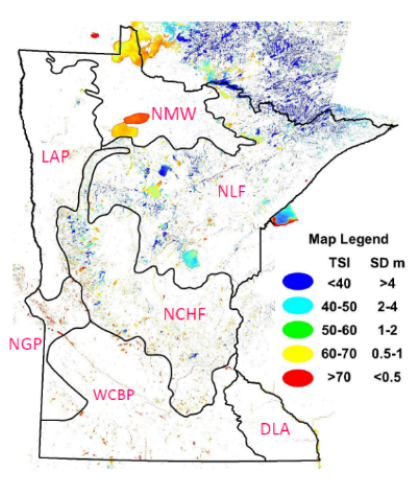Lake water quality monitoring using satellite imagery
A method to process satellite imagery to create surface water clarity maps for large geographical areas.

Applications
- Monitor water clarity of all inland waters
- Improvement of water quality
- Enhancement of aesthetics
- Precautionary lake management
Key Benefits & Differentiators
- Can also estimate colored dissolved organic matter, and chlorophyll
- State of the art accuracy and cost effective
- High temporal (~bi-weekly) & spatial resolution (20 m) – useful for determining causation of water quality impacts
- Continuous, systematic monitoring of inland lakes
- Large scale – developed for Minnesota water but similar methods can be developed for lakes around the world!
Technology Overview
Lake water clarity, commonly determined by how far one can see in a water, is a widely used indicator of the physical, chemical, and biological health of the lake. However currently used techniques suffer from the following limitations: 1) data sampling is limited to one or two locations on a few lakes (i.e. poor sampling resolution), 2) labor intensive and expensive– requires an individual to boat to locations to collect samples and take measurements, and 3) optical variability of lake system limits the accuracy of the measurements to the locations they are collected.
Leveraging satellite imagery, researchers at the University of Minnesota have developed a method for evaluating water clarity remotely. Using imagery obtained from the Sentinel 2 satellites and an image processing algorithm, this method can accurately calculate water clarity data with higher spatial resolution when compared to existing techniques. In addition, after each weekly flyby, the satellite imagery can be analyzed to provide the most up-to-date information (i.e., high temporal resolution). Moreover, this method automatically accounts for the change in seasons, lighting conditions, and cloud coverage to produce accurate water clarity information. Furthermore, this method can be used to collect and estimate water clarity information for large geographic regions and can be used to create useful maps of geospatial patterns and temporal trends. Founders believe that the data can be delivered in a SaaS (software as a service) business model and will scale well with some capital investment.
Phase of Development
TRL: 6-7This method has been demonstrated and developed for Minnesota lakes.
Desired Partnerships
This technology is now available for:- License of data products
- Sponsored research
- Co-development
Please contact our office to share your business’ needs and learn more.
Researchers
- Leif Olmanson, PhD Researcher 6, Department of Forest Resources
- David Porter, PhD Scientific Computing Consultant, Minnesota Supercomputing Institute